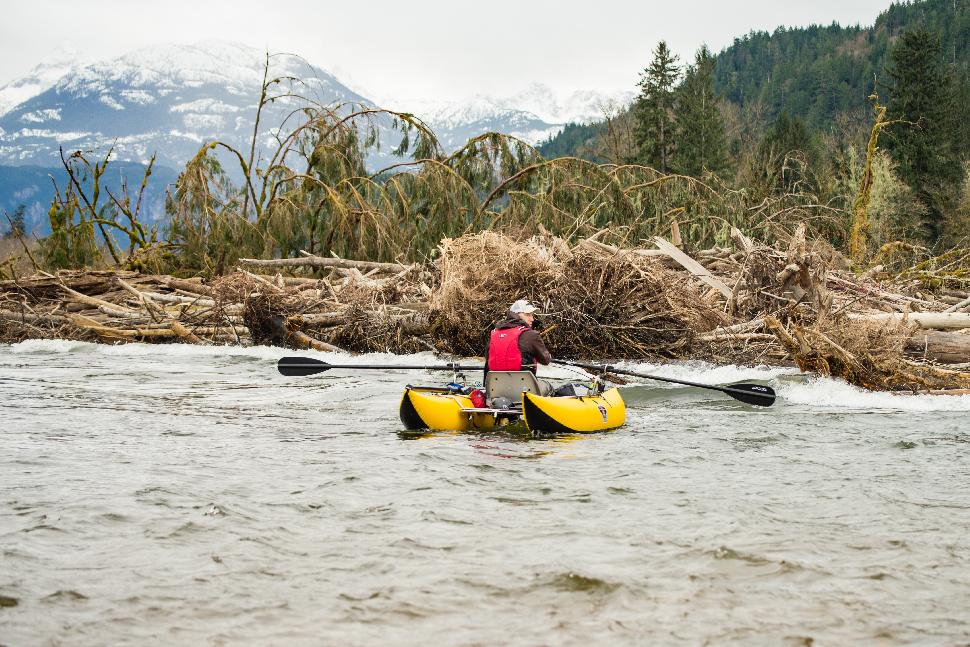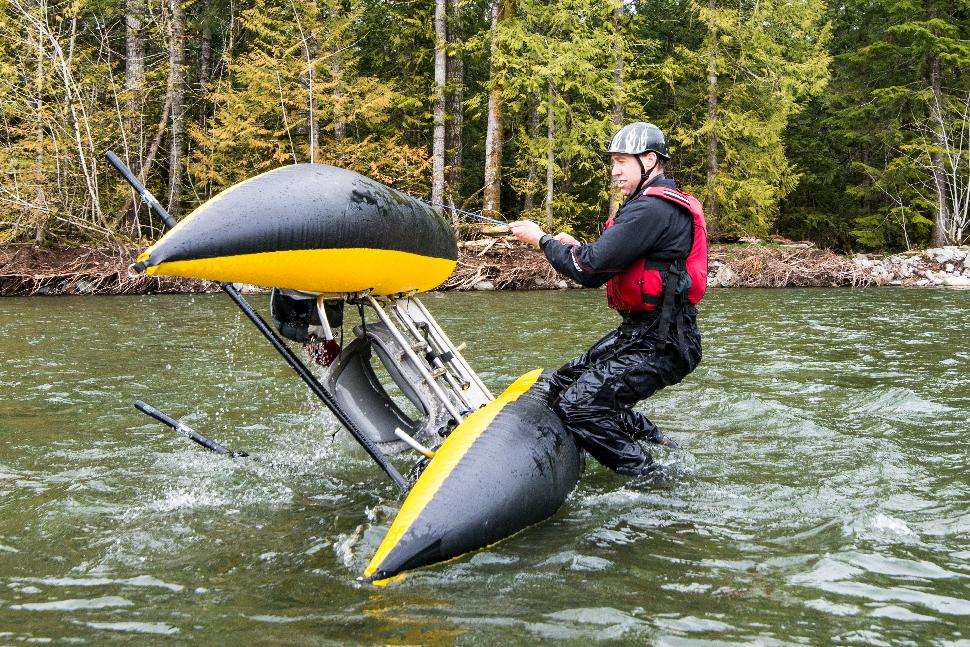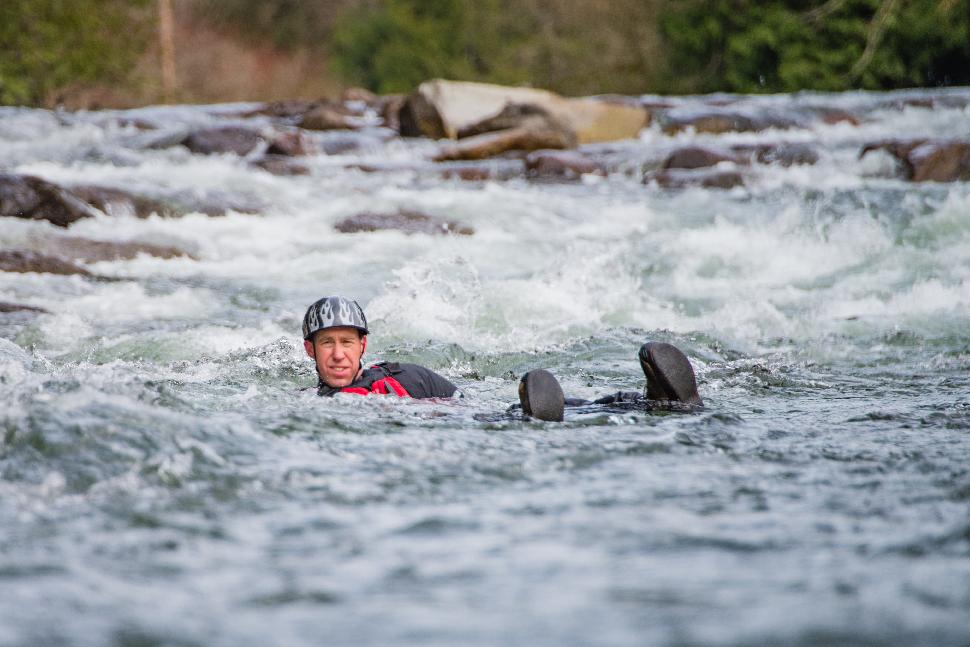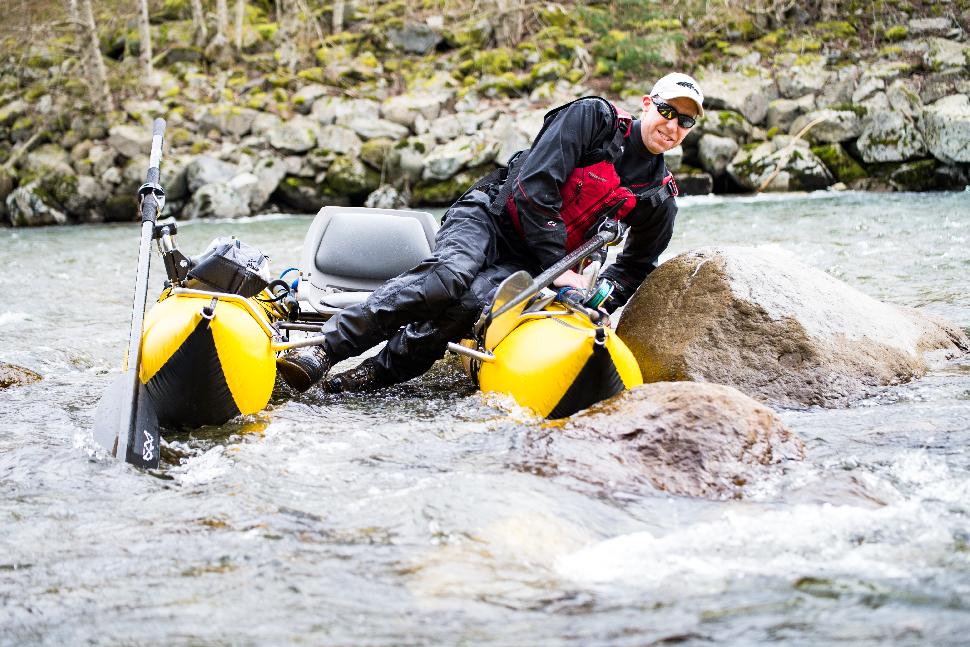You have a pontoon boat, you read my previous article “Gearing up For Safe River Navigation” (May/June 2015, and online) and have all your safety gear, but now how do you actually get down the river safely?
Advertisement
This article will cover a basic overview of key river features, hazards, navigation, self-rescue and some tips for fishing from a boat. This article does not replace hands-on instruction and experience on the river with a knowledgeable mentor. I strongly recommend taking the River Navigation Course designed for anglers offered by Kumsheen Raft Resort (kumsheen.com), which has been training Commercial Raft Guides for 40 years. As one of the lead instructors for the course, I bring almost 30 years of whitewater experience, including 11 years as a Commercial Raft Guide and 18 years of kayaking Class 4-5 rivers, and 2000 river trips. I’m inspired to share my extensive river knowledge with anglers to assist you in gaining the skills and knowledge required to safely navigate rivers.
Basic River Features
For beginners, reading “whitewater” can be overwhelming, and it can be confusing to figure out which route to take. At the entrance of most rapids is a smooth surfaced ramp referred to as the tongue, which is generally V-shaped, with the point of the V facing downstream. Downstream V’s are created by constrictions from rocks, cliffs and shallows. These tongues are a visual clue for the deepest and least obstructed route, which is generally the safest route. On the other hand, an Upstream V (point of V facing upstream) is a visual clue that a subsurface or penetrating obstacle exists and must be avoided to prevent potential damage to your boat.
Advertisement
Eddies
Well before entering a rapid, always look for eddies: they are one of the few features that stop our progression downstream. Eddies are created by obstacles that deflect the main current around them. This creates a void (air pocket) behind the obstacle, and water from downstream flows upstream to fill this void. An eddy line is the feature formed where the upstream current of the eddy meets the downstream current of the main river flow.
Reversals
When large waves can no longer support their own weight, water collapses down the face of the wave, which can cause loss of forward momentum and flip you. Reversals are also known as curlers, breaking waves and stoppers.
Advertisement
Holes
When the river pours over a subsurface rock or ledge, the current descends vertically towards the river bottom, and then along the riverbed. A big air space appears behind the obstacle, and surface water from downstream rushes upstream to fill the void; this upstream current is referred to as the backwash. Many factors determine the intensity of a hole, including its height, width, shape, and depth, and the power and length of the backwash. Large holes have a tendency to wreak havoc. They can flip and recirculate boats, along with the boater, for an extended period.
Propulsion Basics
Before descending rivers, proficiency with these basic strokes is required: backstroke, forward stroke, and double oar turn. The most powerful and commonly used stroke is the backstroke (rowing backwards). The key to the backstroke is using your torso: lean forward with your arms straight and plant your blades into the water (behind you), then lean back with your torso and pull with your arms until your hands are close to your chest. Using your torso will generate more power and eliminate arm fatigue. The backstroke slows your progression downstream and pulls you away from hazards. The forward stroke is primarily used to push your craft through reversing waves or holes. The forward stoke is simply the reverse mechanics of the backstroke: plant your blades in front of you, lean forward with your torso then push with your arms. The quickest stroke to spin your boat is the double oar turn. To turn your boat to the right, pull back with your right oar and simultaneously push forward with your left oar, and vice versa to turn to the left.
Basic Navigation Skills
Generally when floating down rivers we face downstream, so we can continuously analyze for downstream hazards that require manoeuvering. To manoeuvre away from hazards, spin your boat so your bow is facing the hazard, use a 45 degree angle to the current (not the shore), and row away from the hazard using powerful backstrokes. If you feel like you’re not moving across the current, it’s because you’re not. Look over your upstream shoulder to get the correct angle to the current. Get out of the habit of using the shore to set up your angle; the current only flows parallel to the shore in straight, calm sections of the river.

When there’s a bend in the river, always approach on the inside corner. The current is slower on the inside corner because the current is pushed to the outside corner and accelerates around the bend. If there’s a hazard on the inside corner you can easily row to the outside, whereas with strong currents it’s extremely difficult to manoeuvre from the outside corner to the inside corner. Also, if there’s a river-wide hazard or complex rapids downstream, there’s usually a back eddy around the inside corner where you can eddy out. Then you can walk down the shore and scout the hazard or rapid for safe passage. Eddying out refers to entering an eddy to stop your progression downstream.
Entering and Exiting Eddies
Eddies are very important features because they stop our progression downstream – they’re the only brakes we have! There are three components to entering eddies: speed, timing and angle. With a 45 degree angle to the main current, row backwards across the current, timing your strokes to reach the top of the eddy, with enough momentum to penetrate through the eddy line into the eddy. A 45 degree angle is a general guideline. Depending on the size and power of the eddy line, different angles maybe required. When entering the eddy, your boat will spin upstream; counteract by rowing with your upstream oar only.
To exit an eddy there are two recommended methods: row downstream and exit from the bottom of the eddy if it’s relatively calm, or row backwards out of the top of the eddy. To prevent your boat from spinning violently, reduce your angle to 10 – 25 degrees to the main current and gain momentum inside the eddy when rowing backwards out into the main current. Once you cross the eddy line, use more power with your downstream oar to prevent a downstream spin.
Running Reversals and Holes
Avoid larger reversals and holes: they can stop, spin and capsize boats extremely quickly. If dropping into one is unavoidable, then gain forward momentum with hard forward strokes and hit the backwash straight on. When you’re about to hit the backwash, dig deep and lean forward and push yourself through with your oars. But if the backwash is too powerful, flipping is inevitable!
Capsizing
If you’ve ever had the misfortune of capsizing on a cold river, it’s a bit of a shock! Nine times out of ten you’ll be right next to your boat: grab your boat instantaneously, before you become separated. If you’re not right next to your boat, you’ll be within swimming distance: swim aggressively to your boat before the cold water decreases your strength and dexterity. An upside down boat is one BIG PFD, and the only time I’d swim away from my boat is if it’s drifting towards a terminal hazard. If possible, always stay on the upstream side of the boat, to avoid getting pinned between an obstacle and your boat. To re-right your boat, climb up onto your boat, reach across to the opposite tube and grab the frame or a flip line, and pull back towards yourself while putting all your weight on the other tube. Beware of the oars when re-righting your boat!

Swimming and Self-Rescue
Being prepared for self-rescue on rivers is extremely important. If you become separated from your boat, you have two swimming positons that are used for different situations. The defensive swimming position is used when you’re floating down fast shallow sections or rapids with boulders, or to conserve your energy until you get close to an eddy. Float on your back with your feet up and face downstream, and use a backstroke at an angle to the current to manoeuvre yourself to shore or an eddy. This position allows you to look downstream and push off any rocks or other obstacles with your feet.

With your body close to the surface you reduce the potential of hitting submerged obstacles, and prevent foot entrapments. This position will slow you down (the fastest current on a river is 1 1/2 to 2 feet below the surface), which increases your chances of being rescued with a throwbag from another boat. The aggressive swimming position is used to get to shore or back to your boat, to avoid hazards and to break through strong eddy lines. The aggressive swim is the front crawl with your head up. To manoeuvre away from hazards, face upstream with a 45 degree angle to the current and aggressively swim away.
Avoiding Foot Entrapments
NEVER attempt to stand up in knee deep water in a strong current; there are lots of obstacles on the river bottom that can trap your foot. Ever get your foot jammed between a couple of rocks when walking on shore? If this happens in a strong current, the current can push you over and pin you there. This is a grave situation! It’s extremely hard to rescue someone in this situation, and generally becomes a body retrieval. To avoid foot entrapments, wait until your bum is hitting the river bottom, then roll onto your front and crawl onto shore, or swim into an eddy and then climb up onto shore. Never stand up or put your feet down in the water unless it’s below your knees or the water is calm.
River Hazards
Wood is one of the worst hazards on rivers. Sweepers are logs that are slightly elevated above the river. Because sweepers pose a clearance problem, they can sweep you off your boat and/or flip you. Strainers and logjams are considered potentially terminal hazards. Strainers can be anything that lets water pass through, but prevents passage of a person. Strainers can be natural or human-made, with trees being the most common. Logjams are a collection of trees in the water and have the same risk as strainers. These hazards must be avoided at all costs. Aggressively swim around them. If strainers cannot be avoided, face downstream and swim towards the lowest and cleanest spot. Gain momentum and time your strokes so you can plant your hands on the tree, push up with your arms and kick hard with your legs and propel yourself over or on top of the strainer.
Highsiding
When drifting down rivers, sometimes we don’t end up where we’ve planned. If your boat broadsides a rock, you can generally spin yourself off it quickly. Occasionally when the current is stronger, it will push your boat up the rock, while the lower tube (upstream side) submerges deeper into the current, pinning the boat against the rock or capsizing your craft. To prevent this situation from occurring, you’ll need to instantaneously highside. Highsiding is putting your weight on the downstream tube. This reduces weight on the upstream tube, and with the tube’s buoyancy, it’s freed from the river’s current. Instinctively, we avoid momentum towards rocks, but in this case lean over and kiss that rock! Highsiding is effective for any obstacle, whether it’s a rock, strainer, sweeper or logjam.

Boat Fishing Tips
Several rivers have fishing restrictions on fishing from a boat: check the regulations.
Fishing from a boat can be beneficial if you understand where common holding areas are. Slow yourself down by rowing upstream or float in slower currents to observe downstream fishing lies. The best float-fishing angle is roughly 45 degrees upstream of the fish. A down and across presentation using a reach cast allows for the longest drag-free drifts. In general, position your boat within a 35 to 50 foot casting range, where line drag can be minimized and where you’re least likely to be seen by fish.
Boat control
Unless you have the luxury of someone rowing for you while you fish, you’ll need a strategy to prevent boat spin when fishing. One method is to fish with one hand on the oar and use gently correcting strokes to maintain your angle. Another method is to use fins, so you can use both hands for fishing. Master the use of fins on calm water first. Never use fins in shallow water due to the risk of injury. It will be difficult to stand or walk in water and on shore. Quick removal of fins is required should an entrapment situation occur. The most important consideration when fishing is to continuously look downstream for hazards.
Improving the Odds
Drifting rivers solo is not recommended. Having another boater is key for rescue. Only drift rivers within your navigation abilities, and know how to recognize, avoid, and respond to hazardous situation. When a hazardous situation occurs, you often only have seconds to react. Be safe and have fun!
Recommend Courses and Books
Kumsheen’s River Navigation Course – Levels 1 and 2
Toll Free 1-800-663-6667
rafting@kumsheen.com
kumsheen.com
Books
The Complete Whitewater Rafter by Jeff Bennett
Float-fishing Strategies by Neale Steeks